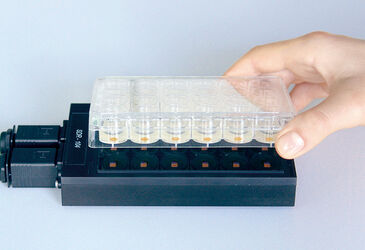Watch tutorials, webinars and informative videos about PreSens optical sensor systems.
Bettina Giere
Tierärztliche Hochschule Hannover, Germany
For optimisation of cell culture systems it is essential to monitor important metabolic parameters like oxygen and pH quantitatively and to readjust them to physiological values if necessary. Deviations from the physiological limits cause substantial changes for cell growth and differentiation. The new SDR SensorDish® Reader enables non-invasive online monitoring of oxygen and pH in cell culture media. This is exemplified by a novel 3D chondrocyte culture model.
The Optimal Growth Matrix
The effect of three different pre-treated collagen matrices on the oxygen metabolism of chondrocytes from porcine rib was investigated in parallel to characterise the optimal growth matrix (Giere, 2005). The SensorDish® Reader (Fig. 1) was used to obtain detailed insights into oxygen consumption and therefore the metabolic activity during cell growth, and to draw first conclusions on the suitability of the three matrices as growth substrate.
Materials & Methods
The three matrices were pre-treated with either one of the following collagenase types: Collagenase A (0.2 %) , Collagenase II (0.1 %) and Collagenase II (0.3 %). Using 24-well OxoDishes® from PreSens the chondrocytes were cultivated on these matrices in parallel (n = 8) over a total period of four weeks. The culture medium in the wells was exchanged in intervals of three days. The oxygen concentration in the culture medium was monitored online during the whole culture period using the SensorDish® Reader software. The individual oxygen consumption per hour and well 24 h after media change was calculated by comparing the oxygen content in the cell culture sample and in the control medium without cells.
Correlation between Collagen Matrix and Oxygen Consumption
A multivariate statistics-analysis of the oxygen consumption of the samples sheds light on the optimal carrier matrix for the chondrocytes. Cultures from matrices pre-treated with Collagenase II (0.1 %) revealed oxygen consumption rates that were 2.9 times higher than cultures on matrices with Collagenase A (0.2 %) pre-treatment (Fig. 2). Concerning the maximum metabolic activity, cultures on matrices with Collagenase II (0.1 %) pre-treatment were found to be the adequate growth substrate. Independent of the collagen matrix all three cultures displayed a significant maximum in metabolic activity after three weeks of cultivation. In the fourth week the metabolic activity decreased significantly.
Precise Statements on Oxidative Metabolism Rates
The presented data show that the non-invasive SensorDish® Reader technology allows quantitatively precise statements on the oxidative metabolism rates of cell cultures under defined physiological conditions. Similar studies could be undertaken to identify e. g. the ideal composition of the culture medium or effects of additional supplement with growth factors on the cell metabolism. Beside cell and tissue cultivation, other fields of application for the new SensorDish® Reader are toxicological in vitro studies which enable the safe testing of potentially noxious agents, drug screening for the identification of physiologically potent new molecules, and environmental analytics (BOD test). The compact and robust SensorDish® Reader allows fast and quantitative insights into metabolic processes while maintaining sterile conditions. It enables highly parallelised, non-invasive oxygen and pH screening for cell culture studies. Research goals can be reached faster reducing efforts and costs considerably.
Literature:
Bettina Giere, 2005, Experimentelle Untersuchungen zur Herstellung einer bioartifiziellen Trachea, Dissertation, Tierärztliche Hochschule Hannover, Germany.




